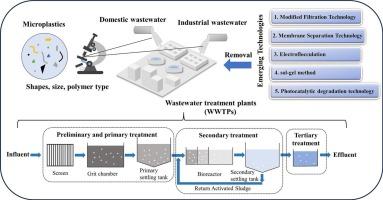Microplastics in wastewater plants: A review of sources, characteristics, distribution and removal technologies
IF 3.5
3区 环境科学与生态学
Q2 ENVIRONMENTAL SCIENCES
引用次数: 0
Abstract
Microplastics (MPs) are widespread in everyday life, and since wastewater treatment plants (WWTPs) serve as an important route for MPs to enter natural water bodies, a thorough understanding of the distribution and removal of MPs in wastewater treatment plants is of great importance. This article provides a comprehensive overview of the measured distribution of MPs and the current status of their removal in wastewater treatment plants. The main sources of MPs in wastewater treatment plants are personal care products in domestic wastewater, textile clothing and industrial wastewater made from plastics, textile factories and the friction of road tires. The MPs that entered the sewage treatment plant were predominantly in the form of fibers, fragments, granular MPs and other types of MPs. The size of MPs is divided into three categories: <0.5 mm, 0.5–1 mm and 1–5 mm. At all treatment stages in wastewater plants, 56.8–88.4 % of MPs are removed in primary treatment, but the primary sedimentation and degreasing stages remove most MPs. The efficiency of the activated sludge process for secondary treatment is inconsistent and is generally between 42.1 and 99.2 %. The coagulation, filtration and disinfection stages of tertiary treatment all have some MPs removal capacity. In addition, novel removal technologies are also described, such as modified filtration technology, membrane separation technology, electroflocculation, sol-gel and photocatalysis. These novel removal technologies can further limit the entry of microplastics into natural water bodies through sewage treatment plants and improved sewage treatment processes help reduce the risk of MPs entering the natural environment through sewage treatment plants. This article will provide reference for the distribution and removal of microplastics in various levels of WWTPs.

污水处理厂中的微塑料:来源、特征、分布和去除技术综述。
微塑料(MPs)广泛存在于日常生活中,而污水处理厂(WWTPs)是微塑料进入自然水体的重要途径,因此全面了解污水处理厂中微塑料的分布和去除情况具有重要意义。本文全面概述了污水处理厂中 MPs 的测量分布和去除现状。污水处理厂中 MPs 的主要来源是生活污水中的个人护理产品、纺织服装以及由塑料、纺织厂和公路轮胎摩擦产生的工业废水。进入污水处理厂的 MPs 主要以纤维、碎片、颗粒状 MPs 和其他类型 MPs 的形式存在。根据 MPs 的大小可分为三类:
本文章由计算机程序翻译,如有差异,请以英文原文为准。
求助全文
约1分钟内获得全文
求助全文
来源期刊

Journal of contaminant hydrology
环境科学-地球科学综合
CiteScore
6.80
自引率
2.80%
发文量
129
审稿时长
68 days
期刊介绍:
The Journal of Contaminant Hydrology is an international journal publishing scientific articles pertaining to the contamination of subsurface water resources. Emphasis is placed on investigations of the physical, chemical, and biological processes influencing the behavior and fate of organic and inorganic contaminants in the unsaturated (vadose) and saturated (groundwater) zones, as well as at groundwater-surface water interfaces. The ecological impacts of contaminants transported both from and to aquifers are of interest. Articles on contamination of surface water only, without a link to groundwater, are out of the scope. Broad latitude is allowed in identifying contaminants of interest, and include legacy and emerging pollutants, nutrients, nanoparticles, pathogenic microorganisms (e.g., bacteria, viruses, protozoa), microplastics, and various constituents associated with energy production (e.g., methane, carbon dioxide, hydrogen sulfide).
The journal''s scope embraces a wide range of topics including: experimental investigations of contaminant sorption, diffusion, transformation, volatilization and transport in the surface and subsurface; characterization of soil and aquifer properties only as they influence contaminant behavior; development and testing of mathematical models of contaminant behaviour; innovative techniques for restoration of contaminated sites; development of new tools or techniques for monitoring the extent of soil and groundwater contamination; transformation of contaminants in the hyporheic zone; effects of contaminants traversing the hyporheic zone on surface water and groundwater ecosystems; subsurface carbon sequestration and/or turnover; and migration of fluids associated with energy production into groundwater.
 求助内容:
求助内容: 应助结果提醒方式:
应助结果提醒方式:


